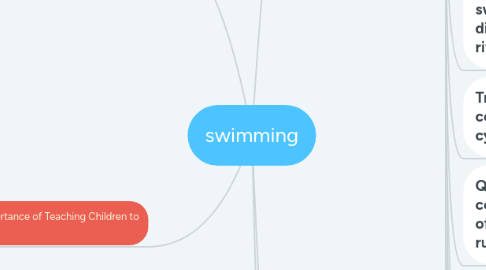swimming
by CERVANTES PI?A JOSE ARTURO


1. vocabulary
1.1. Swimming Strokes Freestyle — in these events competitors can swim using any stroke of their choice. Backstroke — a swimming stroke performed on the back with the arms lifted alternately out of the water in a backward circular motion and the legs extended and kicking. Breaststroke — one of the major swimming strokes, performed with the swimmer with his chest forward and facing towards to bottom of the pool. Butterfly — one of the major swimming stroke styles, swum on the breast, with both arms moving simultaneously, accompanied by a "dolphin kick. Sports Involving Swimming Relay Swimming — a swimming race in which teams of four race consecutively. Open Water Swimming — competitive swimming races conducted over various distances (10km at the Olympics) held in rivers, lakes and oceans. Triathlon — an athletic competition, which consists of three events, usually swimming, cycling, and running in consecutive order. Quadrathlon — an endurance sports event composed of the four individual disciplines of swimming, kayaking, cycling and running - also called quadriathlon. Finswimming — an underwater swimming sport where athletes race against each while wearing breathing apparatus. Aquathlon — a continuous race involving swimming followed by running. Biathle — consists of swimming and running as part of a single race. It is usually over a shorter distance than the similar Aquathlon. Triathle — a shortened version of the Modern Pentathlon, athletes compete in shooting, swimming and running events as a part of a single race. Aquabike — a shortened version of triathlon, with no running leg. Athletes swim followed by cycling. Ironman Surflifesaving — combines four major aspects of surflifesaving into a single race: swimming, board paddling, ski paddling, and beach running. Modern Pentathlon — an event in the Olympics that comprises five events: fencing, 200m freestyle swimming, show jumping, and a combined event of pistol shooting and 3200m cross country run. Synchronized Swimming — athletes perform synchronized dance routines to music while floating in water.
1.2. Swimming Strokes
1.3. Freestyle — in these events competitors can swim using any stroke of their choice.
1.4. Backstroke — a swimming stroke performed on the back with the arms lifted alternately out of the water in a backward circular motion and the legs extended and kicking.
1.5. Breaststroke — one of the major swimming strokes, performed with the swimmer with his chest forward and facing towards to bottom of the pool.
1.6. Butterfly — one of the major swimming stroke styles, swum on the breast, with both arms moving simultaneously, accompanied by a "dolphin kick.
1.7. Sports Involving Swimming
1.8. Relay Swimming — a swimming race in which teams of four race consecutively.
1.9. Open Water Swimming — competitive swimming races conducted over various distances (10km at the Olympics) held in rivers, lakes and oceans.
1.10. Triathlon — an athletic competition, which consists of three events, usually swimming, cycling, and running in consecutive order.
1.11. Quadrathlon — an endurance sports event composed of the four individual disciplines of swimming, kayaking, cycling and running - also called quadriathlon.
1.12. Finswimming — an underwater swimming sport where athletes race against each while wearing breathing apparatus.
1.13. Aquathlon — a continuous race involving swimming followed by running.
1.14. Biathle — consists of swimming and running as part of a single race. It is usually over a shorter distance than the similar Aquathlon.
1.15. Triathle — a shortened version of the Modern Pentathlon, athletes compete in shooting, swimming and running events as a part of a single race.
1.16. Aquabike — a shortened version of triathlon, with no running leg. Athletes swim followed by cycling.
1.17. Ironman Surflifesaving — combines four major aspects of surflifesaving into a single race: swimming, board paddling, ski paddling, and beach running.
2. my personal swimming experience
2.1. I remember when was children my first contac with walter was 6 years old my school the swimming the instituto del seguro social (imss) i was feel scared because not meet are children my teachher give me confiance to introduction at walter.
3. The Importance of Teaching Children to Swim
3.1. The importance of teaching children to swim is widely recognised in society. However, Swim Group found in a recent report that almost a third (31%) of children leave school without being able to swim. These children also leave without basic water safety skills. What’s worrying is both these skills are listed in the current National Curriculum (NC). The current NC doesn’t give teachers much guidance on the age at which swimming lessons should be offered. It merely states a swimming programme should exist at key stages 1 and/or 2. However, a study from 2015 found the ideal age to begin swimming lessons was between five and seven. You can find the full details in our post from March 2015, entitled Between five and seven is the best age to learn to swim.
4. definition
4.1. v
4.1.1. is a great activity for getting fit. But for some people, going up and down a pool can be tedious. Now there's a new trend of dressing up and swimming like a mermaid. It's called mermaiding and although it's aimed at teaching kids to be safe in water, it's catching on with adults too. Find out more about this hobby in 6 Minute English.

